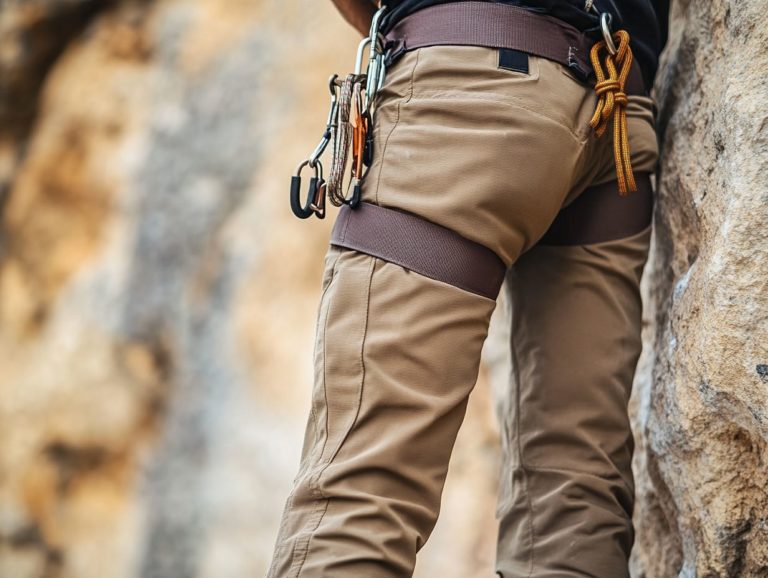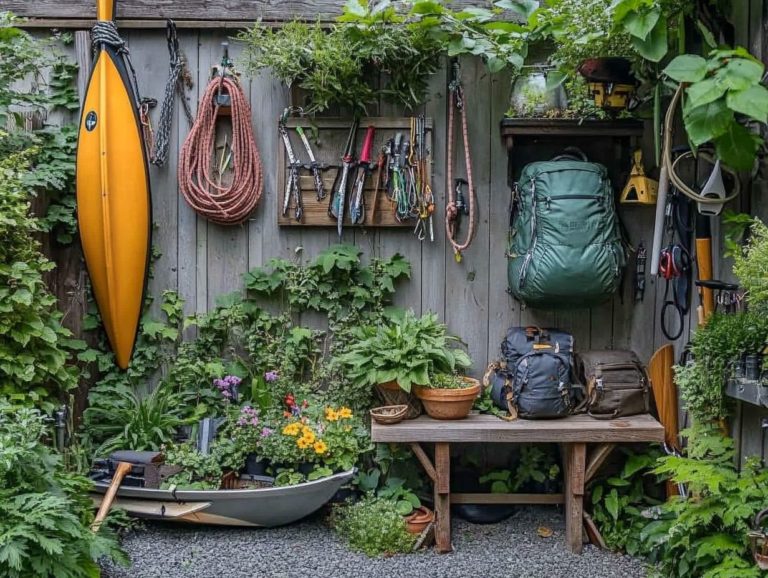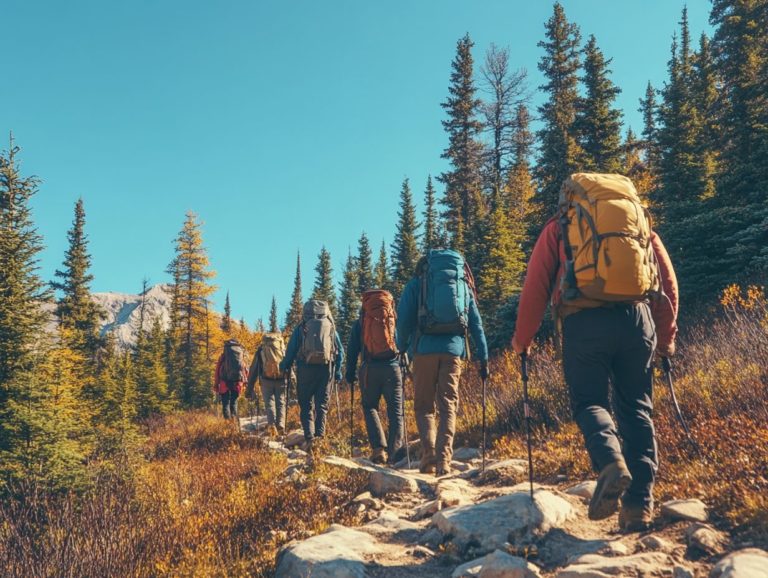10 Quick Tips for Packing Outdoor Clothing
Planning an outdoor adventure? Efficient packing can make or break your experience in the great outdoors.
With unpredictable weather and various activities to consider, knowing what to bring is essential.
Get ready! Here are ten quick tips to pack smartly for your outdoor adventures, ensuring you have all the necessities without overloading your bag.
Whether you’re embarking on a weekend hike or a multi-day camping trip, these insights will keep you prepared and comfortable.
Dive in to uncover the essentials for your next outdoor journey! This includes using compression bags (which minimize clothing volume by removing air) and packing cubes (which keep your items organized).
Contents
- Key Takeaways:
- 1. Consider the Weather and Activities
- 2. Pack Versatile Clothing
- 3. Utilize Compression Bags or Packing Cubes
- 4. Layering Is Key
- 5. Bring a Rain Jacket or Poncho
- 6. Prioritize Sun Protection!
- 7. Pack Lightweight and Quick-Drying Fabrics
- 8. Bring Comfortable and Supportive Shoes
- 9. Consider Bringing a Hat and Other Accessories
- 10. Pack a Small First Aid Kit
- What Are the Essential Items to Pack for an Outdoor Trip?
- How Can One Save Space When Packing Outdoor Clothing?
- What Are Some Common Mistakes to Avoid When Packing Outdoor Clothing?
- How Can One Pack Efficiently for a Multi-Day Trip?
- What Are Some Tips for Packing for Different Types of Outdoor Activities?
- What Are Some Essential Items to Pack for a Winter Outdoor Trip?
- Frequently Asked Questions
- What are the top 10 quick tips for packing outdoor clothing?
- Why is it important to choose versatile clothing for outdoor trips?
- Should I pack different types of layers for different types of weather, especially when traveling to regions like Japan or Europe?
- What should I do if I’m unsure about the weather at my destination?
- Do I need to bring specific clothing for different outdoor activities?
- Can I save space by rolling my clothes instead of folding them?
- Is it necessary to bring a first aid kit for outdoor trips?
Key Takeaways:
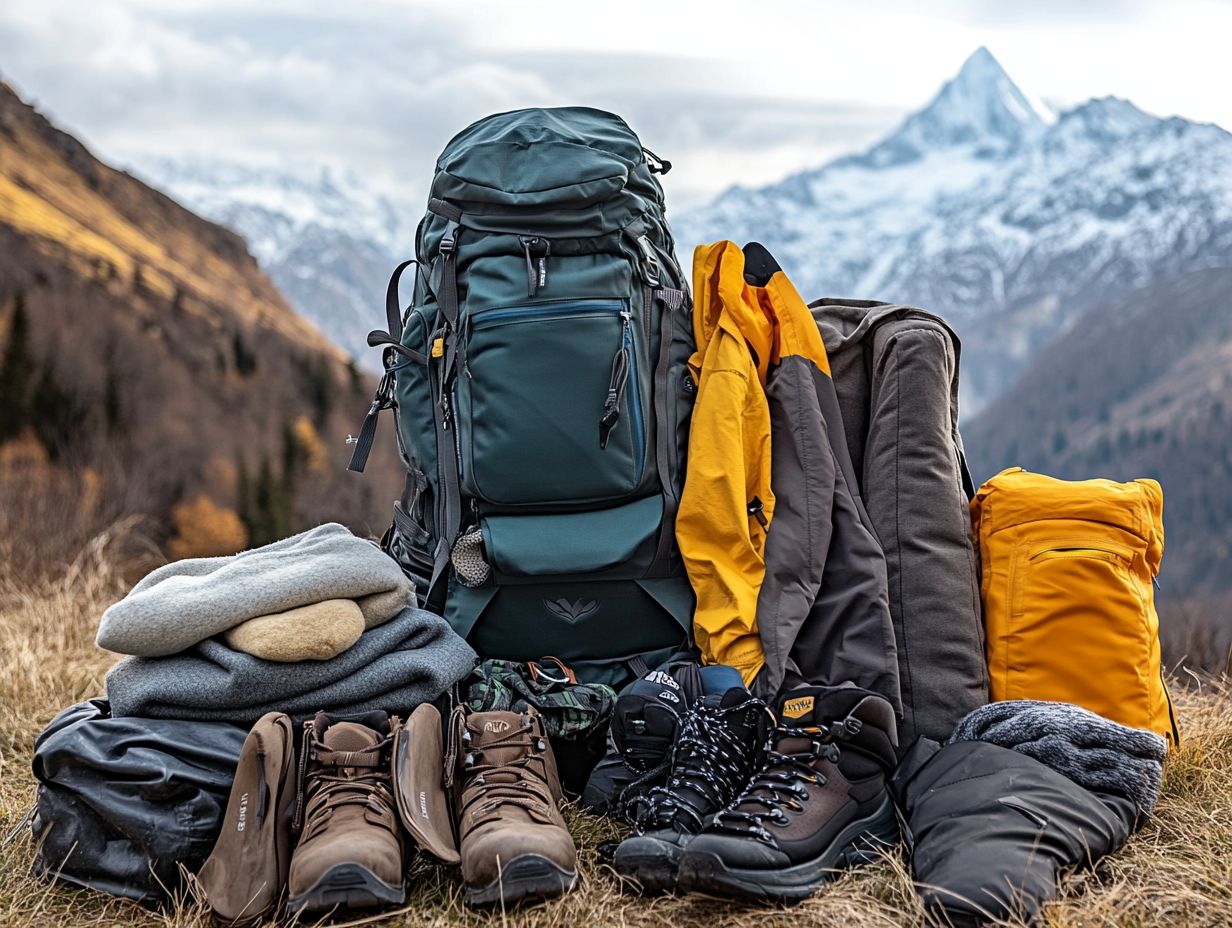
- Consider the weather and activities before packing outdoor clothing. Ensure you pack versatile clothes suitable for your planned activities.
- Utilize compression bags or packing cubes to save space.
- Layering is key for versatility and comfort.
1. Consider the Weather and Activities
When planning your trip, it’s essential to consider both the weather and the activities at your destination.
This foresight ensures you pack clothing that is suitable and comfortable for your adventures, whether you’re wandering through the tranquil temples of Japan or trekking across Europe s stunning landscapes.
The varying climates can significantly influence your packing choices. For instance, if your itinerary features city tours in a warm locale, lightweight clothing and breathable fabrics are paramount.
On the flip side, if your plans include outdoor escapades in a cooler area, layering becomes your best friend, allowing you to easily adjust comfort levels as needed.
You should check reliable weather forecasting apps or websites a week before your departure to fine-tune your packing list. This helps you make necessary adjustments based on expected conditions.
Carrying versatile pieces that can be mixed and matched conserves space and prepares you for any scenario during your travels.
2. Pack Versatile Clothing
Packing versatile clothing is crucial for travelers who want to keep their luggage light while maximizing outfit possibilities.
This approach allows for seamless transitions between various activities and settings during your trip.
For example, consider a simple dress that can easily be elevated with statement jewelry and heels for an evening out. Conversely, you can tone it down with a light cardigan and flats for a day of casual sightseeing.
Layering becomes your best ally. Lightweight jackets or scarves can be added or removed based on shifting weather conditions or social environments.
This strategy minimizes the amount of clothing you need to pack while cultivating a personal packing style that balances practicality with a flair for fashion.
By thoughtfully choosing adaptable pieces, you can ensure a stylish yet efficient wardrobe throughout your travels.
3. Utilize Compression Bags or Packing Cubes
Using compression bags or packing cubes is a great option for travelers like you who seek to maximize space in their luggage.
These tools enhance organization and grant you swift access to essential items while on the move.
By compressing the air from your clothing and belongings, these bags dramatically reduce volume, creating valuable space for additional necessities without the bulk.
Packing cubes allow you to categorize your items, making it effortless to find what you need without sifting through piles of clothing.
If you’re eager to enhance your luggage capacity, you can find these products easily available on platforms like Amazon, where a range of options caters to various needs and preferences.
To make the most of these tools, consider grouping similar items in each cube while reserving compression bags for bulkier items like jackets or sweaters.
This approach will ensure your suitcase remains well-organized and manageable for any journey ahead.
4. Layering Is Key
Layering is a key packing strategy. It keeps you comfortable and adaptable in changing weather.
This method boosts warmth and offers versatility. You can create endless outfit combinations.
For example, start with a lightweight base layer, like a moisture-wicking shirt, paired with a cozy fleece jacket for brisk mornings. Then simply shed the jacket as the afternoon warms up. Adding a weather-resistant outer layer protects against unexpected rain or wind, ensuring you re ready for anything.
Choose quick-drying materials like merino wool or synthetic blends. These fabrics help regulate your temperature and dry quickly, prioritizing comfort without compromising on style or functionality.
5. Bring a Rain Jacket or Poncho
Bringing a rain jacket or poncho is an essential travel tip, especially for outdoor escapades or in areas with unpredictable weather. It serves as a lightweight and effective shield against rain, keeping your other clothes dry.
You can find a variety of rain jackets and ponchos tailored to your needs. Some feature breathable materials that allow sweat to escape while keeping rain out ideal for energetic hikes or bike rides. Others are easy to pack, folding into compact sizes that easily fit into your daypack without adding bulk.
Opt for waterproof materials like Gore-Tex or similar fabrics for durability and comfort. Outdoor retailers, both online and in stores, boast a diverse selection, making it easy to find the perfect fit for any journey.
Including a rain jacket or poncho in your gear makes your adventures worry-free, no matter how sudden the weather changes.
6. Prioritize Sun Protection!
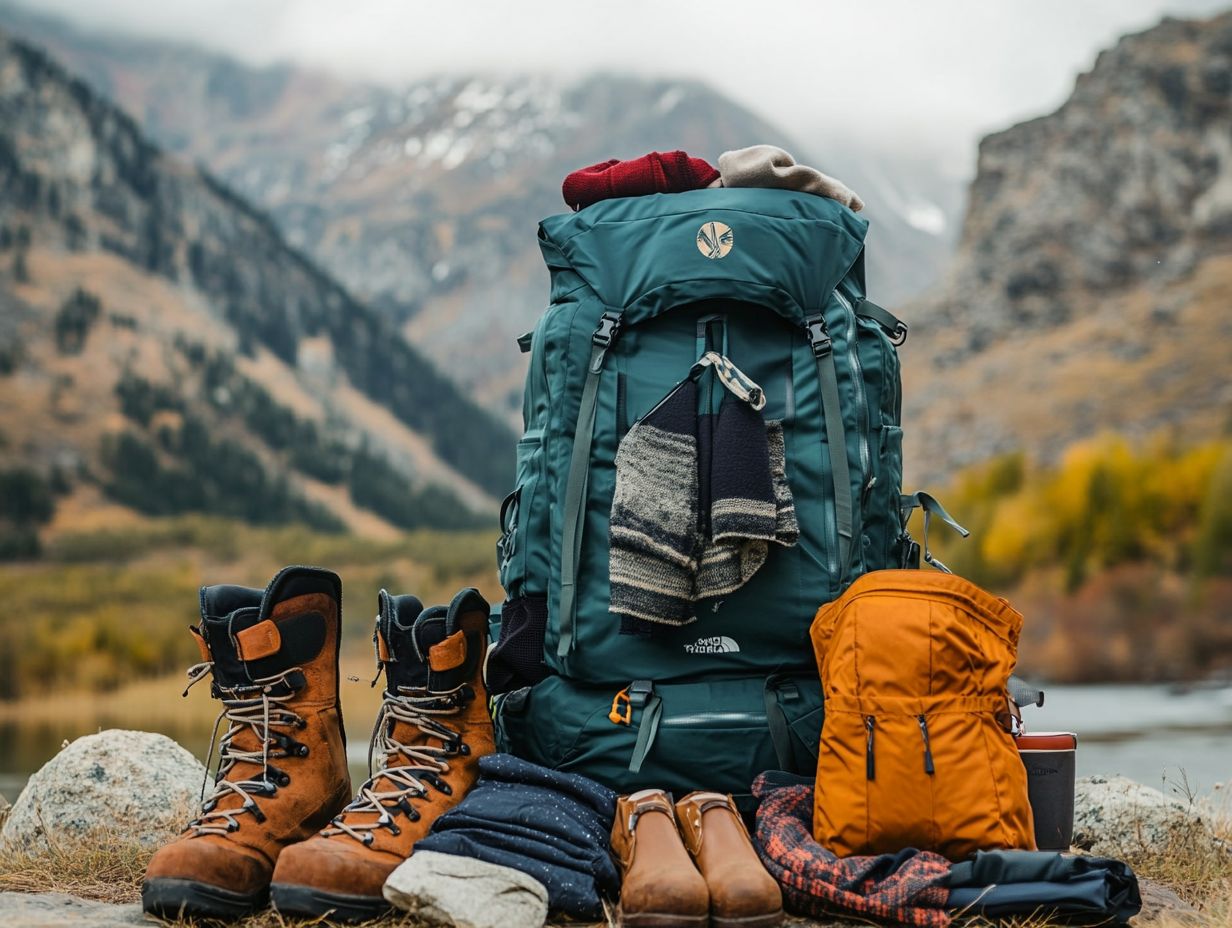
When you’re packing for a trip, don t wait! Protect your skin from harmful UV rays, especially when heading outdoors.
Incorporating sunscreen with the appropriate SPF is key; it shields your skin and helps prevent long-term damage. Understand your skin type for the right SPF level. If you have fair skin, you might need a higher SPF, while those with darker skin tones can opt for a lower SPF and still benefit.
Protective clothing should also be on your radar. Choose lightweight, long-sleeved shirts and pants made from UV-blocking fabrics. And don t forget the accessories! A wide-brimmed hat provides extra shade for your face and neck, while polarized sunglasses keep your eyes safe from glare.
When packing these essentials, consider using packing cubes to organize your sun protection items. This way, you’ll have easy access to everything you need without hassle during your travels.
7. Pack Lightweight and Quick-Drying Fabrics
Packing lightweight and quick-drying fabrics is essential for your journey, allowing for effortless movement and hassle-free laundry solutions while traveling light.
Bouncy materials like polyester and nylon stand out for their durability and rapid drying capabilities, making them perfect for varying weather conditions. Merino wool is another excellent choice; it regulates temperature and wicks moisture away, ensuring comfort throughout your travels.
As you search for these fabrics, check out outdoor gear retailers, specialty clothing stores, and online marketplaces for diverse options. Embrace these lightweight materials to elevate your travel experience and free up valuable luggage space for those adventure essentials.
Discover lightweight options today and transform your travel experience!
8. Bring Comfortable and Supportive Shoes
Bringing comfortable and supportive shoes is essential for any travel itinerary. They keep your feet happy and pain-free, allowing you to immerse yourself fully in your adventures without any discomfort.
Choose the right shoes and step into your adventures! Whether you re wandering through vibrant city streets or conquering rugged hiking trails, the right footwear can elevate your experience significantly. For casual strolls, lightweight sneakers with solid arch support are typically your best bet.
When it comes to hiking, investing in sturdy boots with excellent grip is key to navigating various terrains smoothly. Don t forget to consider your destination’s climate; breathable materials are perfect for warm locales, while waterproof options are a must for those unpredictable wet conditions.
Ultimately, keeping your itinerary in mind will help you make the best choices, ensuring that every journey is as enjoyable as it s meant to be.
9. Consider Bringing a Hat and Other Accessories
Bringing a hat is a travel tip you might often overlook, but it can elevate your style and functionality while protecting you from the sun s rays during outdoor escapades. Using compression bags, which are bags that help save space when packing, can also save space when packing your hats.
You have a variety of options at your disposal, each serving a unique purpose. For example, wide-brimmed hats are perfect for sun protection on beach days or hiking adventures. Pair them with a good backpack to easily carry your essentials.
On the other hand, baseball caps exude a relaxed vibe that’s just right for casual outings or sporting events.
Regarding packing these accessories, keeping them in shape is crucial. For structured hats, consider placing them in a protective bag or using packing cubes to prevent any deformation. Using airtight bags can also help keep them fresh during your travels.
Meanwhile, softer hats can often be rolled or folded, fitting snugly into your luggage to ensure they arrive in pristine condition, ready for your adventures. Employ compact rolling techniques to make the most of your space.
10. Pack a Small First Aid Kit
Packing a small first aid kit is a game changer for your travels, giving you peace of mind as you explore! It prepares you for minor injuries or ailments, so you can focus on your adventures.
When putting this kit together, include the essentials:
- Adhesive bandages for cuts and scrapes,
- Antiseptic wipes to ward off infections,
- Cosmetics for personal care,
- Pain relievers to tackle headaches or discomfort.
It s also prudent to add a small roll of gauze, some medical tape, and a pair of tweezers for those pesky splinters. Organize items in plastic bags for quick access. To make the most of your space, opt for a durable, zippered pouch and organize items by category.
Additionally, familiarize yourself with any regulations surrounding carry-on luggage, as there may be restrictions on liquids or specific medical supplies. Knowing the TSA guidelines can significantly ease your journey.
What Are the Essential Items to Pack for an Outdoor Trip?
When gearing up for your outdoor adventure, it is essential to pack certain items that will guarantee your safety, comfort, and enjoyment. Employing packing techniques that suit your personal style will enhance your experience. Consider everything from the right clothing to gear tailored for your specific activities.
Think about the various pursuits you might embark on whether you are hiking through rugged terrain, setting up a cozy campsite for a weekend escape, or diving into an exhilarating kayaking experience. Always remember to travel light to maintain your mobility. Each activity demands specialized equipment, such as sturdy boots for hiking trails, a high-quality tent for camping under the stars, or a reliable life jacket to keep you afloat while kayaking. Don’t forget to pack your dry bags for waterproof storage.
Your packing techniques are crucial for maximizing space. Try packing items like a puzzle to save space. Compression bags, special bags that squeeze air out to save space, can minimize bulk effectively. Organizing your gear into dedicated compartments ensures quick access to necessities. A thoughtful arrangement boosts efficiency and enhances your overall experience, allowing for seamless transitions between activities. Additionally, before your next adventure, consider how to choose outdoor clothing to streamline your packing. Aim to minimize liquids to streamline security checks.
How Can One Save Space When Packing Outdoor Clothing?
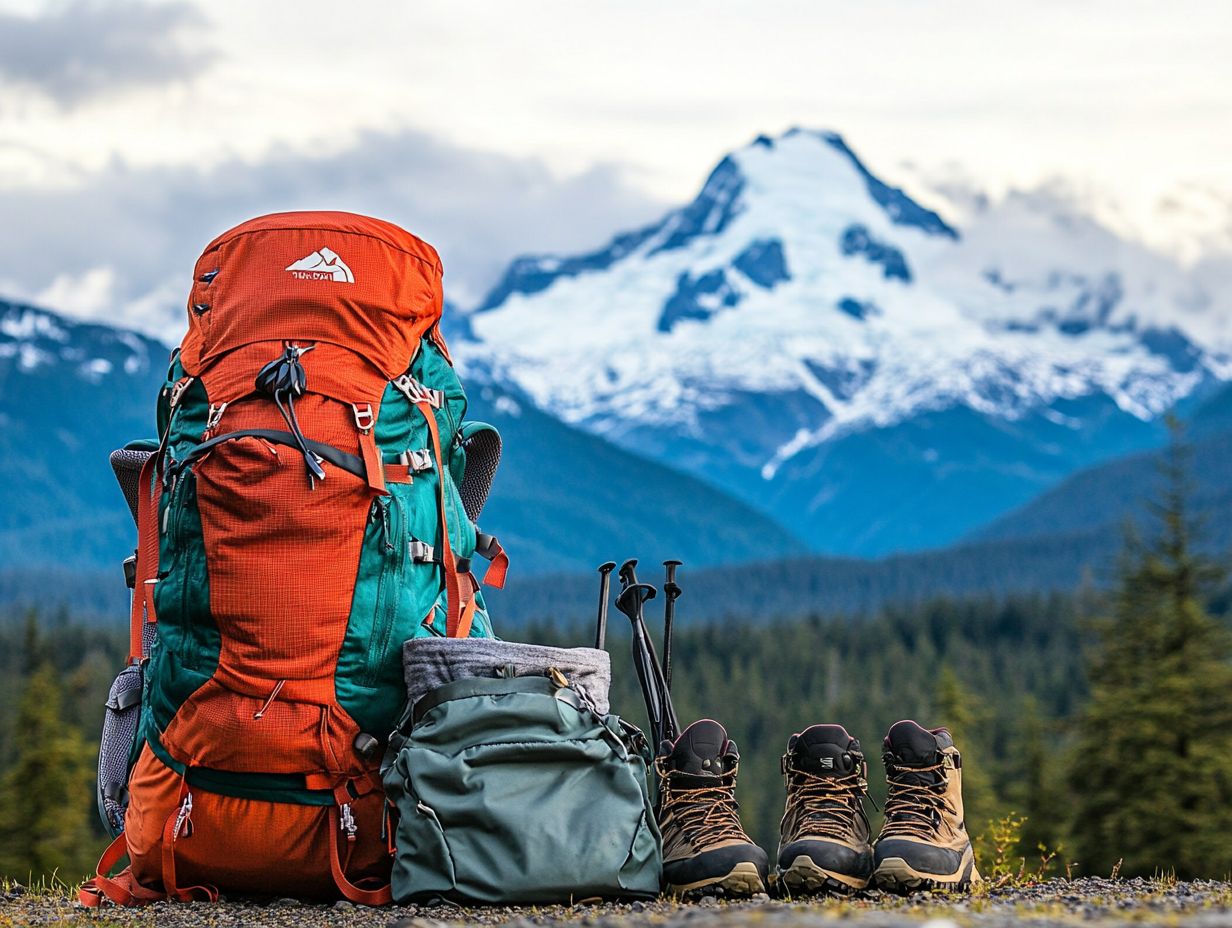
To optimize space when packing your outdoor clothing, consider employing a few clever techniques, such as rolling your clothes, using compression bags, and selecting multi-functional items like a jacket that doubles as a raincoat.
Rolling your clothes is a fantastic method; it not only minimizes creases but also allows you to maximize space in your luggage. This is part of my personal packing style. This approach helps you fit in more items while providing a clear view of everything at a glance, so you can easily avoid the hassle of rummaging through layers.
Compression bags can be a true game-changer, especially for bulkier garments like jackets or sweaters. By removing excess air, these bags reduce volume significantly, creating a compact bundle that is perfect for your outdoor adventures.
Choosing multi-functional pieces, such as a jacket that doubles as a raincoat and a stylish layer, ensures you maximize your limited packing space. Consider how you can organize luggage to keep these items accessible. This way, you can bring only what you truly need without sacrificing style or comfort.
What Are Some Common Mistakes to Avoid When Packing Outdoor Clothing?
When packing outdoor clothing, it is easy to fall into common traps that can lead to discomfort or a lack of preparedness think overpacking, ignoring the weather, or forgetting essential items such as toiletries and cosmetics.
These oversights can turn an exhilarating adventure into a logistical headache. Planning your pack efficiently with packing tips can save you from stress. You might overlook how quickly the weather can shift, leaving you with inadequate layers or gear that simply is not suited for sudden rain or a drop in temperature. To avoid this, check out these tips for staying dry in outdoor clothing. Plus, the urge to cram in extra gear can add unnecessary weight, making your hikes physically taxing and uncomfortable.
The solution? Careful planning is crucial. Use packing methods that suit each outdoor adventure for the best results. Take the time to research local climate patterns, including average temperatures and precipitation. This is particularly important if you are traveling to destinations like Japan or Europe. Additionally, consider following essential tips for caring for outdoor apparel to ensure your packing list features versatile, weather-appropriate apparel.
Don’t forget to check British airports for any travel rules; it is a game changer! Using a ‘packing list’ technique can dramatically reduce the chances of forgetting crucial items, paving the way for a more enjoyable outdoor experience. Consider adding items like first aid kits to your list, and explore how to pack your outdoor accessories efficiently. Ultimately, embracing adaptability and foresight in your preparations can make all the difference in truly savoring the spirit of adventure. Pack wisely to ensure a smooth adventure!
How Can One Pack Efficiently for a Multi-Day Trip?
Packing efficiently for a multi-day trip demands a touch of artistry in planning and organization. You need to ensure you have everything you need while keeping your luggage light and manageable. Practice Tetris packing to maximize your space.
To set the stage for success, start with a comprehensive packing list. This handy tool keeps you organized and stress-free! It helps you identify essential items and sidesteps that last-minute packing frenzy that can derail even the most seasoned travelers. Don’t forget to include detergent sheets for laundry on long trips.
Choosing versatile clothing is crucial. Think of pieces that can be mixed and matched or styled in multiple ways. This strategy significantly reduces the number of items you need to bring along.
Consider employing packing methods like compression bags, which are bags that reduce the volume of your clothing, saving space. Meanwhile, packing cubes offer an elegant solution for keeping your belongings organized and easily accessible. For more tips on how to pack efficiently for outdoor adventures, using dry bags for wet items can also be beneficial.
Don’t forget to prioritize your essentials items like toiletries, cosmetics, and chargers should be readily available. This spares you the hassle of sifting through layers of clothing when you need them most.
What Are Some Tips for Packing for Different Types of Outdoor Activities?
When packing for various outdoor adventures, it s essential to customize your strategy to align with the unique requirements of each activity. Whether it s a family trip or a solo journey, adjust accordingly. This guarantees you have the right gear and clothing for an enjoyable experience. Always consider the weight and bulkiness of your items.
For example, when hiking, your focus should be on lightweight essentials that prioritize mobility and comfort, especially if you’re navigating rugged terrain. Select fabrics that keep sweat away from your skin to stay dry and comfortable on the trail. For added protection, consider following safety tips for outdoor clothing care. Remember to pack accordingly for the weather.
On the other hand, when camping, your gear may need to be a bit bulkier, emphasizing durability and versatility. Ensure you have a high-quality tent for comfort. For guidance on outdoor clothing, consider how to dress for a successful outdoor adventure. Organizing your gear effectively is crucial; consider using packing cubes or dry bags to separate items, making access a breeze. This organization helps when packing for a trip to the Amazon or other vast landscapes.
It s also smart to limit liquids by choosing solid alternatives, like bar soaps or compact food items. This not only aids in complying with TSA regulations but also keeps the overall weight of your pack manageable. With this thoughtful approach, your outdoor experience will be significantly enhanced, allowing for greater ease whether you re navigating the trail or settling in at camp.
What Are Some Essential Items to Pack for a Winter Outdoor Trip?
For your winter outdoor trip, packing the right essentials is crucial to ensure warmth, safety, and enjoyment in the cold. Make sure you have a well-thought-out plan before you leave. Focus on packing techniques that work best for cold weather.
As you prepare for this adventure, prioritize thermal layers that wick away moisture while providing ample insulation. These layers help maintain body heat when temperatures drop. Investing in high-quality waterproof outerwear is essential to protect yourself from snow and rain. Don’t forget an additional layer for added warmth. Also, don’t overlook the importance of durable winter footwear, which offers both stability and comfort on icy surfaces. For more guidance, check out these tips for packing light with outdoor clothing. This will help you navigate challenging conditions safely.
Regarding packing, roll your clothing to save space and keep your gear organized in compartments. Using airtight bags can help with moisture control. Ensure that your liquids, like hydration packs or gels, comply with TSA regulations for a smooth travel experience. Additionally, consider checking out the 5 essential outdoor clothing items for beginners to ensure you’re well-prepared. This ensures you can pass through security checkpoints with ease and have easy access to your items without risking delays.
Frequently Asked Questions
What are the top 10 quick tips for packing outdoor clothing?
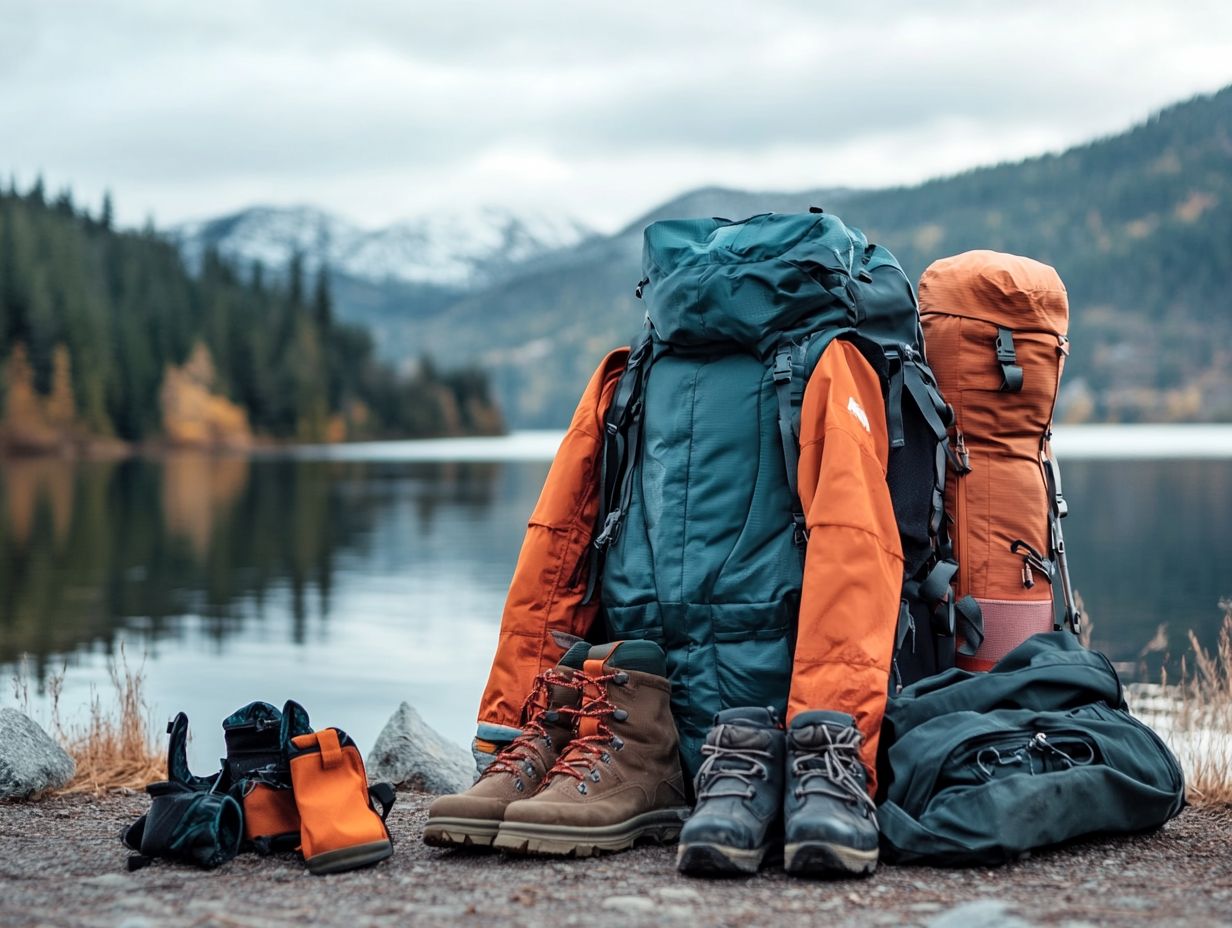
1. Choose versatile, lightweight clothing! This way, you can rock multiple outfits without the bulk.
2. Don’t let unexpected rain ruin your adventure! Always pack a reliable rain jacket or waterproof layer.
3. Roll your clothes instead of folding them. This saves space and helps prevent wrinkles.
4. Pack layers for cold weather. Avoid heavy, bulky items that take up precious space.
5. Protect yourself from the sun! Bring a hat, sunglasses, and sunscreen.
6. Bring a pair of comfortable, sturdy shoes for hiking or outdoor activities.
7. Consider your destination and planned activities when choosing what to pack.
8. Use space-saving bags or compression cubes to maximize space and keep your clothes organized.
9. Don’t forget appropriate socks and undergarments for your outdoor adventures!
10. Be prepared for anything! Bring a small first aid kit with essentials like bandages and insect repellent.
Why is it important to choose versatile clothing for outdoor trips?
Versatile clothing works for various activities. It saves space in your luggage, especially when using space-saving bags.
Should I pack different types of layers for different types of weather, especially when traveling to regions like Japan or Europe?
Be ready for different weather conditions! Pack layers that can be easily added or removed, so you stay comfortable no matter what Mother Nature throws your way.
What should I do if I’m unsure about the weather at my destination?
Always be prepared! Pack a rain jacket or waterproof layer in your carry-on luggage for peace of mind, ensuring you stay dry during unexpected rain.
Do I need to bring specific clothing for different outdoor activities?
Yes! Consider the activities you’ll be doing and pack appropriate clothing. For hiking, bring comfortable, sturdy shoes. For swimming, pack a swimsuit, towel, and detergent sheets for washing.
Can I save space by rolling my clothes instead of folding them?
Absolutely! Rolling your clothes saves space and prevents wrinkles. This technique is especially helpful for bulkier items like sweaters or jackets.
Is it necessary to bring a first aid kit for outdoor trips?
Yes, it’s always wise to have a small first aid kit handy. Include essentials like bandages, pain relievers, and insect repellent. You never know when you’ll need it!


